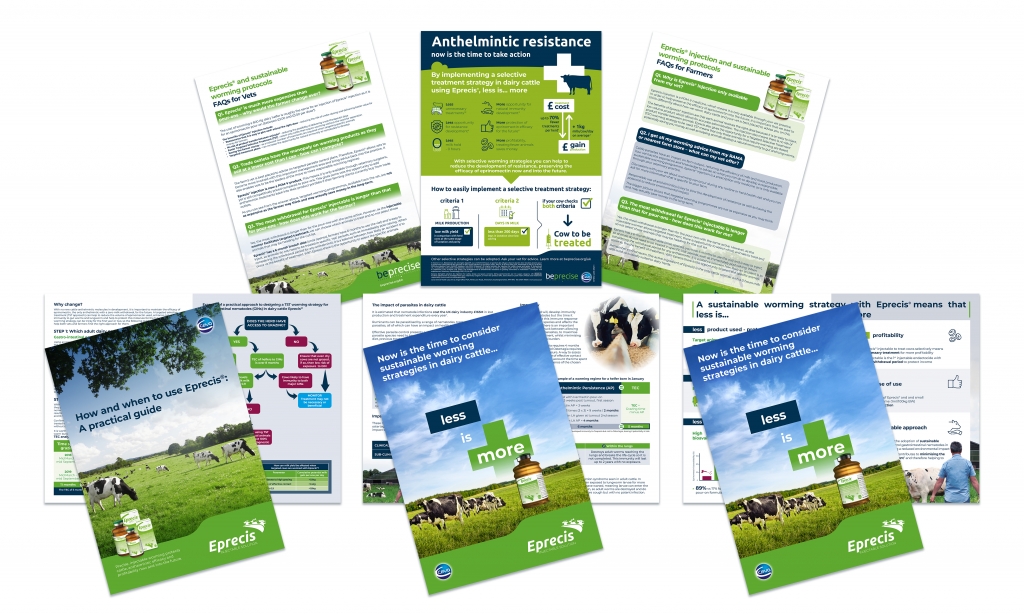
Eprecis Injection Is Now A POM-V, Creating Opportunities For Vets
Ceva Animal Health is pleased to announce that its zero-milk withdrawal, injectable wormer for cows, Eprecis, has changed its legal category from POM-VPS to POM-V.
This change gives vets the opportunity to get more involved in parasite control plans and have an impact on this important management area on farms. Parasites in cattle can reduce the efficiency of milk and meat production and vets are in a good position to provide the support and experience needed to help farmers develop a sustainable parasite control strategy on their farm.
Eprecis injectable contains eprinomectin as its active ingredient, the only molecule with zero-milk withdrawal currently available for cattle on the U.K. market. With concern about increasing resistance1 to cattle wormers and no new zero-milk with-hold active ingredients on the horizon, sustainable worming strategies can help reduce the amount of eprinomectin used and assist in preserving the efficacy of this important molecule for the future.
Sustainable, selective worming practices, which target specific animals or groups that require and therefore will benefit from treatment, result in less active ingredient being used. These selective treatment strategies can help maintain the population of worms in refugia and so allow natural immunity to be developed.
Eprecis is an injection, so there is no risk of product transfer between in-contact animals caused by licking2,3,4, a natural behaviour of cattle, potentially resulting in sub-therapeutic levels of product being absorbed. There is also no risk of reduction in efficacy if dirt or manure is present on the back of the animal5. The injectable formulation results in less active ingredient per animal treated compared to eprinomectin pour-ons; for example using Eprecis injection, a 500kg animal receives 100mg eprinomectin, while a pour-on delivers 250mg per application.
To support the new POM-V classification, Ceva has launched an eye-catching new vet support pack to aid veterinary professionals when talking to their farming clients about Eprecis, worming strategies and their parasite control plans. The comprehensive pack contains a farmer targeted brochure, farmer Q&A and a practical guide with suggestions of when Eprecis can be used. It also includes a useful infograph for social media posts, a technical booklet and a vet Q&A to help answer the most common questions they may be asked. A series of social media posts are available for vet practices encouraging their clients to discuss worming with their vet.
Kythé Mackenzie BVSc MRCVS, ruminant veterinary adviser at Ceva Animal Health, comments: “Ruminants can be parasitised by a range of nematodes, trematodes and external parasites, all of which can have an impact on health and production. A recent publication considered that helminth infections (GIN, lungworm and liver fluke) cost the UK dairy industry close to £145M per year6. Interestingly, the majority of these costs were attributed to lost production (£131M) rather than treatment costs (£14M).
“There is now documented resistance to eprinomectin in small ruminants7 (Haemonchus contortus in goats) and whilst not yet documented in cattle, action needs to be taken to try and delay/minimise this emergence. This requires the use of more sustainable parasite control plans to assist in managing refugia and allowing animals adequate exposure to the parasites to develop natural immunity. Parasite control plans should maximise health, welfare and production whilst minimising the unnecessary use of anthelmintics.”
In the short-term, orders of Eprecis injectable from veterinary wholesalers will be fulfilled by the current POM-VPS product that is in the supply chain before switching to the new packaging later in the season.
For further information on Eprecis injectable or the Eprecis injectable marketing pack, which is available either printed or electronically depending on preference, please contact your local Ceva Animal Health territory manager or email [email protected].
References
- Thomas Geurden et al., (2015) Anthelmintic resistance to ivermectin and moxidectin in gastrointestinal nematodes of cattle in Europe: International Journal for Parasitology: Drugs and Drug Resistance Volume 5, Issue 3, Pages 163-171.
- Laffont, C. M., Bousquet-Mélou, A., Bralet, D., Alvinerie, M., Fink-Gremmels, J., & Toutain, P. L. (2003). A pharmacokinetic model to document the actual disposition of topical ivermectin in cattle. Veterinary research, 34(4), 445-460.
- Bousquet-Mélou, A., Mercadier, S., Alvinerie, M., & Toutain, P. L. (2004). Endectocide exchanges between grazing cattle after pour-on administration of doramectin, ivermectin and moxidectin. International journal for parasitology, 34(11), 1299-1307.
- Bousquet-Mélou, A., Jacquiet, P., Hoste, H., Clément, J., Bergeaud, J. P., Alvinerie, M., & Toutain, P. L. (2011). Licking behaviour induces partial anthelmintic efficacy of ivermectin pour-on formulation in untreated cattle. International journal for parasitology, 41(5), 563-569.
- COWS: https://www.cattleparasites.org.uk. Administering anthelmintics effectively.
- Charlier et al (2020). Initial assessment of the economic burden of major parasitic helminth infections to the ruminant livestock industry in Europe. Prev. Vet. Med. 182:105103.
- Bordes L. et al., 2020. First report of multiple resistance to eprinomectin and benzimidazole in Haemonchus contortus on a dairy goat farm in France. Parasitol. Int. 76, 102063.
More from Ceva

 3 years ago
3 years ago  1088 views
1088 views
